
Savage Beauty is an exhibition that you could see at the MET museum in New York until August 8th.. It is just amazing, and it would be fantastic to see it live.
The exhibition celebrates the late Alexander McQueen’s extraordinary contributions to fashion. From his Central Saint Martins postgraduate collection of 1992 to his final runway presentation, which took place after his death in February 2010. McQueen challenged and expanded the understanding of fashion beyond utility to a conceptual expression of culture, politics, and identity.
The exhibition features approx. 100 ensembles and 70 accessories from McQueen’s prolific 19-year career. Drawn primarily from the Alexander McQueen Archive in London, with some pieces from the Givenchy Archive in Paris as well as private collections, signature designs including the “bumster” trouser, the kimono jacket, and the three-point “origami” frock coat are on view. McQueen’s fashions often referenced the exaggerated silhouettes of the 1860s, 1880s, 1890s, and 1950s, but his technical ingenuity always imbued his designs with an innovative sensibility that kept him at the vanguard.
The Romantic Mind
“You’ve got to know the rules to break them. That’s what I’m here for, to demolish the rules but to keep the tradition.” — Alexander McQueen
McQueen doggedly promoted freedom of thought and expression and championed the authority of the imagination. In so doing, he was an exemplar of the Romantic individual, the hero-artist who staunchly follows the dictates of his inspiration. “What I am trying to bring to fashion is a sort of originality,” he said. McQueen expressed this originality most fundamentally through his methods of cutting and construction, which were both innovative and revolutionary. This technical ingenuity was apparent as early as his graduation collection from the Fashion Design MA course at Central Saint Martins College of Art and Design in London. Entitled Jack the Ripper Stalks His Victims (1992), it introduced such iconic designs as the three-point “origami” frockcoat. In his first collection after graduating, entitled Taxi Driver (autumn/winter 1993–94), McQueen launched his “bumsters,” pants that sat so low on the hips that they revealed the buttocks. Indeed, McQueen was such a confident designer that his forms and silhouettes, such as the “bumster,” were established from his earliest collections and remained relatively consistent throughout his career. Referring to his early training on Savile Row in London, he said, “Everything I do is based on tailoring.” McQueen’s approach to fashion, however, combined the precision and traditions of tailoring and patternmaking with the spontaneity and improvisations of draping and dressmaking—an approach that became more refined after his tenure as creative director of Givenchy in Paris from 1996 to 2001. It is this approach, at once rigorous and impulsive, disciplined and unconstrained, that underlies McQueen’s singularity and inimitability.
Featured objects: Coat, Jack the Ripper Stalks His Victims; “Bumster” Skirt, Highland Rape; Dress, Plato’s Atlantis; Jacket, Joan; Jacket, It’s a Jungle Out There; Coat, Dante
Romantic Gothic and Cabinet of Curiosities
“People find my things sometimes aggressive. But I don’t see it as aggressive. I see it as romantic, dealing with a dark side of personality.” —Alexander McQueen
One of the defining features of McQueen’s collections is their historicism. He was particularly inspired by the 19th century, especially the Victorian Gothic. “There’s something . . . kind of Edgar Allan Poe, kind of deep and kind of melancholic about my collections,” McQueen noted. Indeed, the “shadowy fancies” that Poe writes about in “The Fall of the House of Usher” (1839) are vividly present in the majority of McQueen’s collections, most notably Dante (autumn/winter 1996–97), Supercalifragilisticexpialidocious (autumn/winter 2002–3), and the posthumous, unofficially entitled Angels and Demons (autumn/winter 2010–11). McQueen’s collections often reflect opposites such as life and death, lightness and darkness. Indeed, the emotional intensity of his runway presentations was frequently the consequence of the interplay between dialectical oppositions. The relationship between victim and aggressor was especially apparent, particularly in his accessories. He once remarked, “I . . . like the accessory for its sadomasochistic aspect.” This position is strikingly evident in the gallery “Cabinet of Curiosities,” which focuses on atavistic and fetishistic paraphernalia produced by McQueen in collaboration with a number of accessory designers, including the milliners Dai Rees and Philip Treacy and the jewelers Shaun Leane, Erik Halley, and Sarah Harmarnee.
Featured objects: Ensemble, Dante; Ensemble, Supercalifragilisticexpialidocious; Ensemble, autumn/winter 2010; Dress, The Horn of Plenty; Ensemble, Eclect Dissect; “Spine” Corset, Untitled; “Coiled” Corset, The Overlook; Ensemble, The Hunger; Dress, It’s Only a Game; Ensemble, No. 13; Dress, No. 13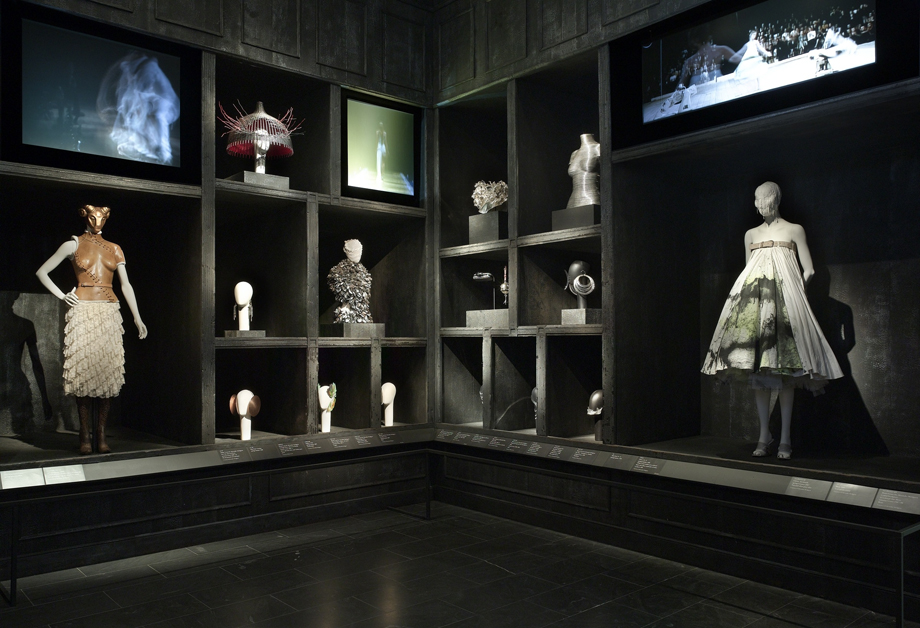
Romantic Nationalism
“The reason I’m patriotic about Scotland is because I think it’s been dealt a really hard hand. It’s marketed the world over as . . . haggis . . . bagpipes. But no one ever puts anything back into it.” —Alexander McQueen
McQueen’s collections were fashioned around elaborate narratives that are profoundly autobiographical, often reflecting his Scottish heritage. When he was asked what his Scottish roots meant to him: “Everything.” McQueen’s national pride is most evident in the collections Highland Rape (autumn/winter 1995–96) and Widows of Culloden (autumn/winter 2006–7). Both explore Scotland’s turbulent political history. Highland Rape was based on the 18th-century Jacobite Risings and the 19th-century Highland Clearances, and was the first collection to introduce McQueen tartan. Shown on semi-naked, blood-spattered models that staggered down a runway strewn with heather and bracken, the clothes were intended to counter romantic images of Scotland. In contrast, Widows of Culloden, which was based on the final battle of the Jacobite Risings, was more wistful, featuring exaggerated silhouettes inspired by the 1880s. McQueen’s message, however, remained defiantly political: “What the British did there was nothing short of genocide.” Despite these heartfelt declarations of his Scottish national identity, McQueen felt intensely connected to England “London’s where I was brought up. It’s where my heart is and where I get my inspiration”. His deep interest in the history of England was most apparent perhaps in The Girl Who Lived in the Tree (autumn/winter 2008–9), a dreamy quixotic fairy tale inspired by an elm tree in the garden of McQueen’s country home near Fairlight Cove in East Sussex. Influenced by the British Empire, it was one of McQueen’s most romantically nationalistic collections, albeit heavily tinged with irony and pastiche.
Featured objects: Dress, Highland Rape; Suit, Highland Rape; Ensemble, Widows of Culloden; Dress, Widows of Culloden; Ensemble, The Girl Who Lived in the Tree; Ensemble, The Girl Who Lived in the Tree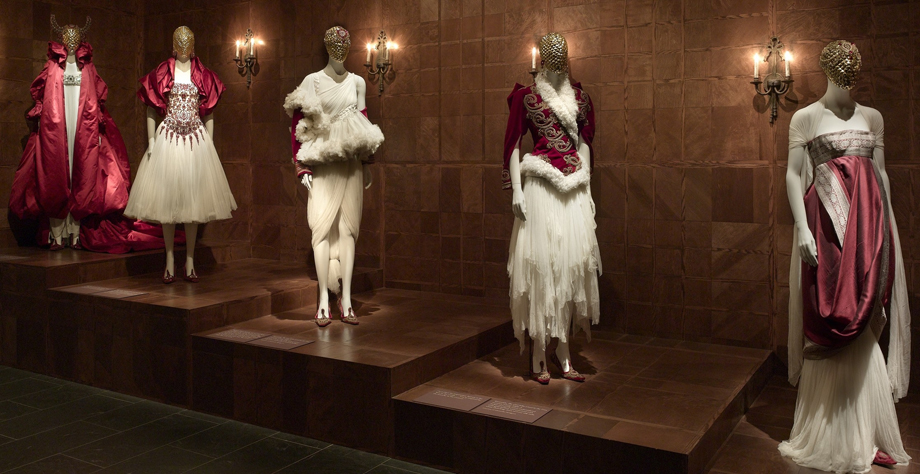
Romantic Exoticism
“I want to be honest about the world that we live in, and sometimes my political persuasions come through in my work. Fashion can be really racist, looking at the clothes of other cultures as costumes. . . . That’s mundane and it’s old hat. Let’s break down some barriers.” —Alexander McQueen
McQueen’s romantic sensibilities expanded his imaginary horizons not only temporally but also geographically. As it had been for Romantic artists and writers, the lure of the exotic was central to his work. Like his historicism, McQueen’s was wide ranging—India, China, Africa, and Turkey all sparked his imagination. Japan was particularly significant to him, both thematically and stylistically. The kimono, especially, was a garment that he reconfigured endlessly. Remarking on the direction of his fashions, McQueen said, “My work will be about taking elements of traditional embroidery, filigree, and craftsmanship from countries all over the world. I will explore their crafts, patterns, and materials and interpret them in my own way.” As with many of his themes, however, McQueen’s exoticism was often expressed in contrasting opposites. That was the case with It’s Only a Game (spring/summer 2005), a show staged as a chess game inspired by a scene in the film Harry Potter and the Sorcerer’s Stone (2001), which pitched the East (Japan) against the West (America). Films often inspired 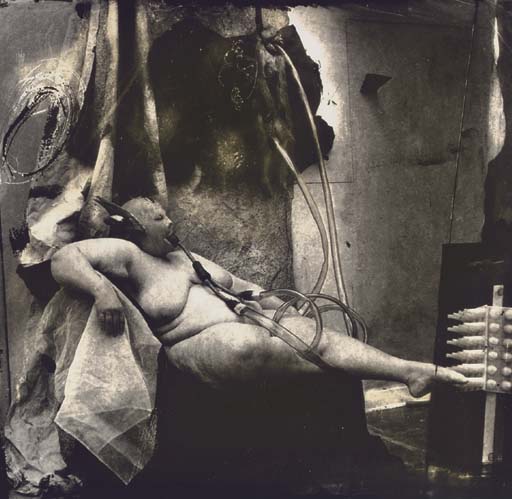 McQueen, as did contemporary art. VOSS (spring/summer 2001), which featured a number of exoticized garments, including a coat and a dress appliquéd with roundels in the shape of chrysanthemums, was inspired by a photograph of Joel-Peter Witkin entitled Sanitarium (1983), which depicted an obese woman connected via a breathing tube to a stuffed monkey. On McQueen’s runway, the fetish writer Michelle Olley played the role of the woman. Typical of McQueen’s collections, VOSS offered a commentary on the politics of appearance, upending conventional ideals of beauty. For McQueen, the body was a site for contravention, where normalcy was questioned and the spectacle of marginality was embraced and celebrated.
McQueen, as did contemporary art. VOSS (spring/summer 2001), which featured a number of exoticized garments, including a coat and a dress appliquéd with roundels in the shape of chrysanthemums, was inspired by a photograph of Joel-Peter Witkin entitled Sanitarium (1983), which depicted an obese woman connected via a breathing tube to a stuffed monkey. On McQueen’s runway, the fetish writer Michelle Olley played the role of the woman. Typical of McQueen’s collections, VOSS offered a commentary on the politics of appearance, upending conventional ideals of beauty. For McQueen, the body was a site for contravention, where normalcy was questioned and the spectacle of marginality was embraced and celebrated.
Featured objects: Ensemble, It’s Only a Game; Ensemble, It’s Only a Game; Ensemble, VOSS; Ensemble, VOSS; Dress, VOSS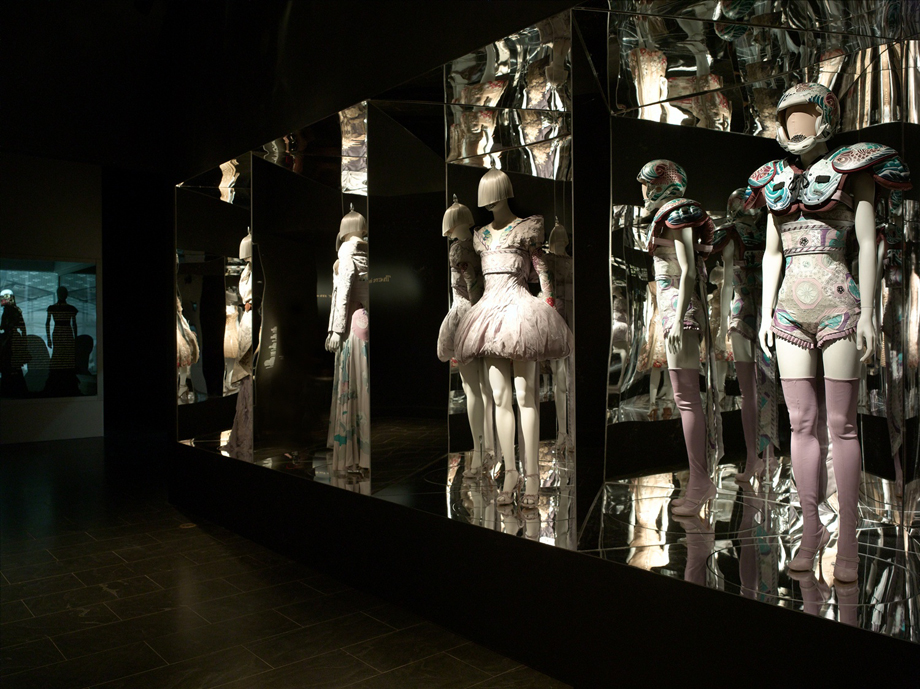
Romantic Primitivism
“I try to push the silhouette. To change the silhouette is to change the thinking of how we look. What I do is look at ancient African tribes, and the way they dress. The rituals of how they dress. . . . There’s a lot of tribalism in the collections."—Alexander McQueen
Throughout his career, McQueen returned to the theme of primitivism, which drew upon the ideal of the noble savage living in harmony with the natural world. It was the focus of his first runway collection after graduating, Nihilism (spring/summer 1994). He said of the collection, “It was a reaction to designers romanticizing ethnic dressing, like a Masai-inspired dress made of materials the Masai could never afford.” It famously included a latex dress with locusts, McQueen’s statement on famine. Many of the pieces were coated with mud, a conceit the designer repeated in Eshu (autumn/winter 2000–2001), a collection inspired by the well-known deity in the Yoruba religion. The clothes, including a coat of black synthetic hair and a dress of black horsehair embroidered with yellow glass beads, came close to fetishizing materials. This fetishization also occurred in It’s a Jungle Out There (autumn/winter 1997–98), which was inspired by the Thomson’s gazelle. The collection was a meditation on the dynamics of power—in particular, the relationship between predator and prey. Indeed, McQueen’s reflections on primitivism were frequently represented in paradoxical combinations, contrasting “modern” and “primitive,” “civilized” and “uncivilized.” The storyline of Irere (spring/summer 2003) involved a shipwreck at sea and was peopled with pirates, conquistadors, and Amazonian Indians. Typically, McQueen’s narrative glorified the state of nature and tipped the moral balance in favor of the “natural man” or “nature’s gentleman” unfettered by the artificial constructs of civilization.
Featured objects: Coat, Eshu; Dress, Eshu; Ensemble, Eshu; Bodysuit, It’s a Jungle Out There; Ensemble, It’s a Jungle Out There; “Oyster” Dress, Irere 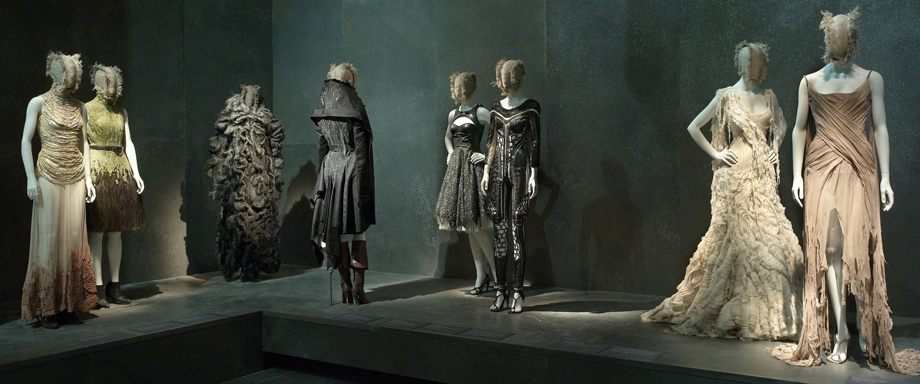
Romantic Naturalism
“I have always loved the mechanics of nature and to a greater or lesser extent my work is always informed by that.” —Alexander McQueen
Nature was the greatest, or at least the most enduring, influence upon McQueen. It was also a central theme, if not the central theme, of Romanticism. Many artists of the Romantic movement presented nature itself as a work of art. McQueen both shared and promoted this view in his collections, which often included fashions that took their forms and raw materials from the natural world. For McQueen, as it was for the Romantics, nature was also a locus for ideas and concepts. That is most clearly reflected in Plato’s Atlantis (spring/summer 2010), the last fully realized collection the designer presented before his death in February 2010. Inspired by Charles Darwin’s On the Origin of Species (1859), it presented a narrative that centered not on the evolution of humankind but on its devolution. The collection was streamed live on Nick Knight’s SHOWstudio.com in an attempt to make fashion into an interactive dialogue between creator and consumer. For the Romantics, nature was the primary vehicle for the Sublime—starry skies, stormy seas, turbulent waterfalls, vertiginous mountains. In Plato’s Atlantis, the Sublime of nature was paralleled and supplanted by that of technology—the extreme space-time compressions produced by the Internet. It was a powerful evocation of the Sublime and its coincident expression of the Romantic and the postmodern. At the same time, it was a potent vision of the future of fashion that reflected McQueen’s sweeping imagination.
Featured objects: Dress, Plato’s Atlantis; “Jellyfish” Ensemble, Plato’s Atlantis; Dress, Widows of Culloden; Dress, Sarabande; Dress, Widows of Culloden; Dress, Sarabande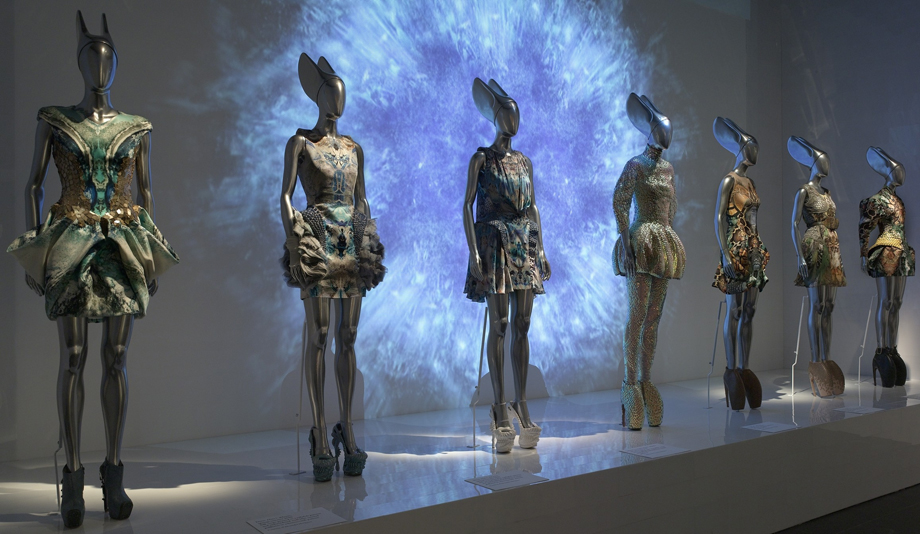
One of the most memorable pieces from Alexander McQueen, that I think that you all will recognise is the sculls-scarf.
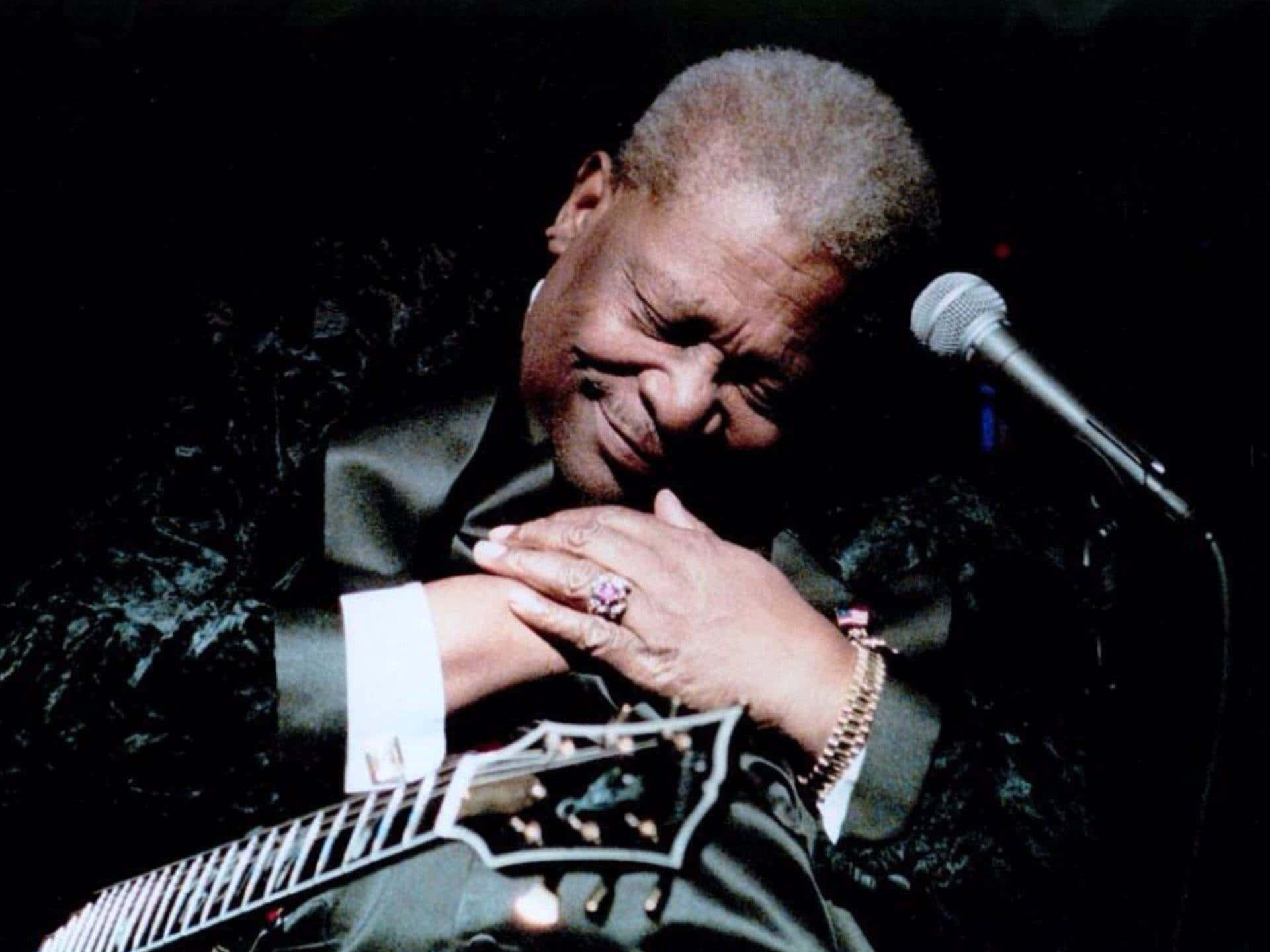 xoxo,
xoxo,
Vicky

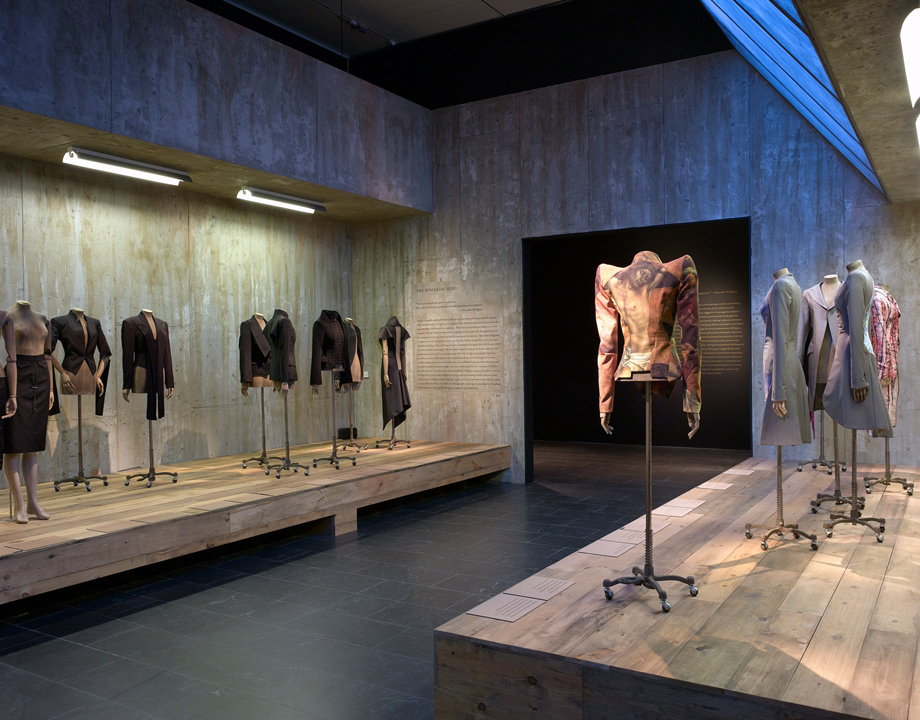
1 comment:
Have you ever considered about adding a little bit more than just
your articles? I mean, what you say is important and everything.
Nevertheless just imagine if you added some great images or videos to give your posts more, "pop"!
Your content is excellent but with pics and video clips, this website could undeniably be one of the most beneficial in its niche.
Wonderful blog!
Also visit my site :: Eurocardsharing
Post a Comment